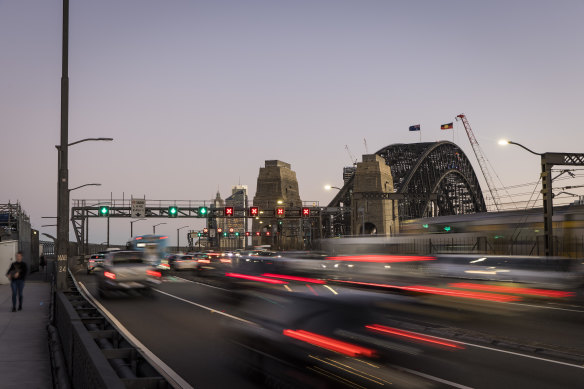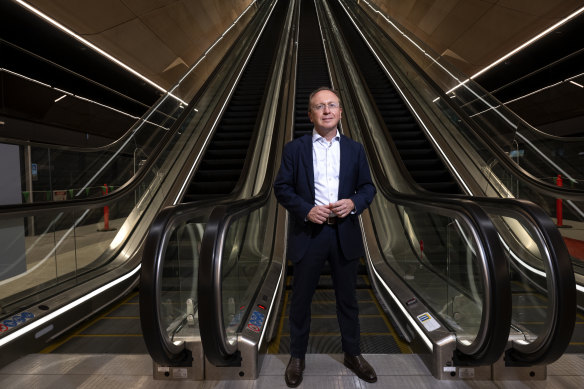Why Sydney Harbour Bridge almost got another rail line over it
Converting two traffic lanes to rail tracks and running a metro train line over the Sydney Harbour Bridge, instead of through twin tunnels beneath the harbour floor were among early plans seriously considered for the city’s new $21.6 billion metro line.
One of the options canvassed within the Coalition government for the metro line between Chatswood and Sydenham via the central city early last decade would have resulted in four rail tracks crossing the famed coathanger, including those for double-decker trains on the north shore line.
Sydney Metro chief executive Peter Regan said an option in the early days of the mega project was to run metro trains over the bridge in the lanes now occupied by the Cahill Expressway, extending the line from North Sydney to Wynyard.
The bridge’s lanes seven and eight were originally designed for heavy rail and they were used by trams until the 1950s, when they were converted to road.
Early last century John Bradfield, the engineer who oversaw the design of the harbour bridge and significant parts of Sydney’s rail network, had also planned for a railway to cross the coathanger’s eastern side – in what are now lane seven and eight – to service the northern beaches.
About 80 years after the bridge opened, the early plans to extend the driverless metro line over it were borne out of Treasury’s fears that tunnelling under the harbour would be too expensive.

Two traffic lanes would have been removed from the Sydney Harbour Bridge if plans to run the metro line over the coathanger had been realised. Credit: Anna Kucera
However, crossing the coathanger would have required major refurbishments of Wynyard and North Sydney stations because of the route it would follow, while the removal of two of the eight traffic lanes from the bridge would have slashed its ability to handle up to 160,000 vehicles a day.
The proposal went before cabinet but it did not progress after it was found that the cost would have been greater than to tunnel under the harbour, as well as it duplicating the North Shore rail line instead of boosting rail passenger capacity elsewhere.
Piles and building basements south of Wynyard station also acted as barriers to the line continuing southwards under that part of the CBD.
“Getting up to the surface at North Sydney and coming across [the bridge], and then getting down into Wynyard, was very, very difficult. Once you got to Wynyard, where would you go?” Regan said.

Sydney Metro chief executive Peter Regan.Credit: Louise Kennerley
Even now, the alignment of the tunnels, which were carved out of sandstone for the Metro City and Southwest project, are “very tight” between the new Barangaroo and Martin Place stations.
“If you’re coming down under the Harbour Bridge, a very tight turn to the left and a tight turn to the right to kind of weave across to get to Martin Place [was needed],” Regan said.
“Martin Place was always viewed as a really, really logical place to go. You’re right in the centre of the business district. Also, that sort of cross connection with the Eastern Suburbs line really opens up a huge journey possibility for people coming from the east to then get up to North Sydney and Chatswood.”
Regan, who worked for a period on London’s mega Elizabeth rail line project, said the final decision to tunnel under the harbour opened up the possibility of building an extra station at Barangaroo. “Originally, there wasn’t a station planned at Barangaroo,” he said.
“The original investment decision ... in 2014 had five underground stations. The key ones were always Vic Cross at North Sydney, Martin Place, Pitt Street, which is now Gadigal, and Central.”
A station at Waterloo was also added to the project in late 2015 after the suburb won out in a two-horse race with the University of Sydney.
Under the original plans, the line was to have been built at grade along the existing rail corridor from Chatswood to St Leonards. However, those plans were later altered so that it would run through tunnels along that section.
“It wouldn’t have been as fast,” Regan said of the surface-level option. “Also I understand it would have meant taking out Artarmon station and rebuilding it. It would have been hugely disruptive.”
Progress on the first stage of Sydney’s metro network, a line to Tallawong in Sydney’s north-west, boosted confidence that tunnelling was doable. “Actually, it’s incrementally not that much more expensive to keep tunnelling once you’ve started,” Regan said. “There were lots of people at the time who didn’t believe that that next bit would come so quickly or at all.”
The new line between Chatswood and Sydenham was due to open on August 4 but the opening has been delayed due a combination of problems including a lack of final approval from the national rail safety regulator and a recent meltdown of a connecting stretch of line.
A new date for the opening hinges on an assessment by Fire and Rescue NSW, and the rail safety regulator issuing an operating licence to the private operator.
The regulator on Friday said it had now received all the evidence to support the operational safety case for passenger services and was continuing its assessment. “The assessment is now well advanced,” a spokesman said.
Start the day with a summary of the day’s most important and interesting stories, analysis and insights. Sign up for our Morning Edition newsletter.